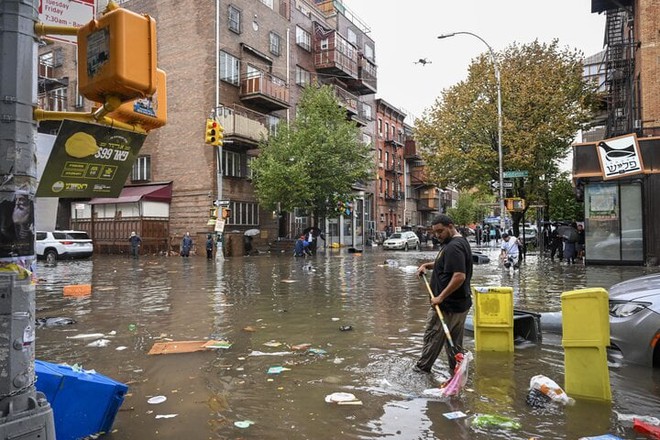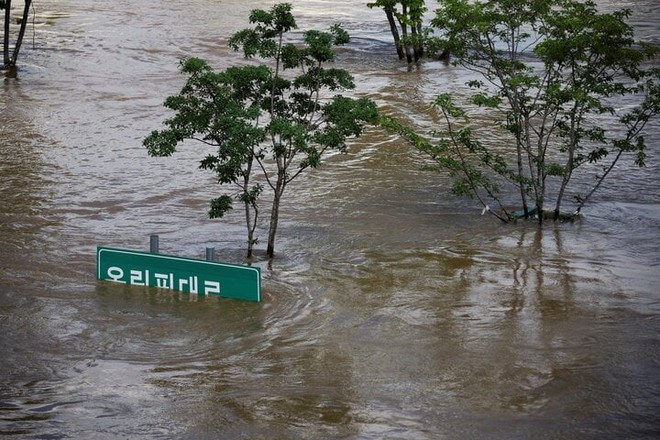Days after the historic rainfall, Dubai is still submerged – a poignant example of the world’s losing battle in the “race against time” with climate change.
The recent floods in Dubai have underscored the failure of urban construction techniques in a major trial related to climate change. The world is witnessing numerous extreme weather events, proving that no matter how large and modern a city is, it is still vulnerable to unprecedented floods.
The wealthy city of the UAE and similar cities are built on areas that were previously uninhabitable. Ironically, this outcome reflects that the urban development ideas of the 20th century have led to “choking” natural water absorption systems.
An ambulance abandoned in floodwaters after the historic rainfall in Dubai. (Photo: Getty)
Population growth, leading to more waste, necessitates additional landfills and waste disposal methods. This formula makes water drainage a challenge for major cities globally like Dubai, especially when facing larger and more frequent rainfall.
From April 15-16, the UAE experienced over 250 mm of rainfall in some areas, nearly half of which fell in Dubai. This was equivalent to the average annual rainfall in the UAE. The increasingly frequent rainfall in recent years in the UAE is expected to worsen in the coming years, especially as daily rainfall amounts increase.
Claims were made last week that the cloud-seeding experiments conducted by the UAE contributed to the historic rainfall, but this information was refuted by the country’s authorities and many experts.
Dubai is not designed to drain water during large, unusual rainfall events; in the photo, people are seen navigating the flooded streets of Dubai on April 17. (Photo: Reuters)
It should be noted that Dubai is built on sand, a natural environment where water easily permeates the ground. However, by constructing large amounts of concrete on the city’s natural terrain, urban developers have effectively prevented the land from absorbing water. Last week’s rainfall was the highest recorded since the country began tracking data in 1949.
Ana Arsky, CEO of the environmental startup company 4 Habitos Para Mudar o Mundo, one of the climate experts interviewed by CNBC about Dubai last week, said: “The city once had natural water outlets that directed water directly to aquifers and then to water reserves. But after paving with asphalt, they no longer exist.”
The explosion in population growth associated with the global urbanization trend adds to the waste problem, and although waste may not be visible on Dubai’s streets, it has to go somewhere – often in less-than-ideal locations. Plastic waste does not absorb water, and when dumped into landfills worldwide, these massive piles of waste contribute to clogging natural drainage systems.

Even long-standing cities with stable drainage systems are facing similar issues, as New Yorkers witnessed last autumn when schools, roads, and homes were flooded, and public transportation ground to a halt after receiving 125 mm to 200 mm of rainfall in a single day.
New York flooded and littered after the September 2023 flood. (Photo: Getty)
Tiago Marques, co-founder and CEO of Greenmetrics.AI, said: “Rainwater drainage systems do not respond to the current trend of extreme climate change and extremely concentrated rainfall. Excess water ultimately leads to urban flooding, even in tunnels, highways, or the lowest points in cities.”
Marques noted that people tend to blame city officials when floods occur because drainage systems were not cleaned properly, but in Porto, Portugal, serious flooding occurred in some areas last year despite the drainage system being cleaned. He added: “The rising and unusually high water essentially sweeps everything away, including debris, into previously clean drainage systems, clogging them. When this water starts to accumulate, authorities will find it very difficult to control the situation everywhere at once.”
“The phenomena that used to happen once every 100 years… are starting to happen every 10 years. Then, floods that occurred once every 10 years are now starting to happen every few years. Adapting to climate change requires us to develop more advanced technologies,” emphasized the CEO.

Seoul streets turned into rivers after the historic rainfall in 2022. (Photo: Reuters)
Arsky concluded that more frequent floods in the world’s most densely populated environments are a stark reminder of the global challenge: There is nowhere escaping the impact of climate change.












